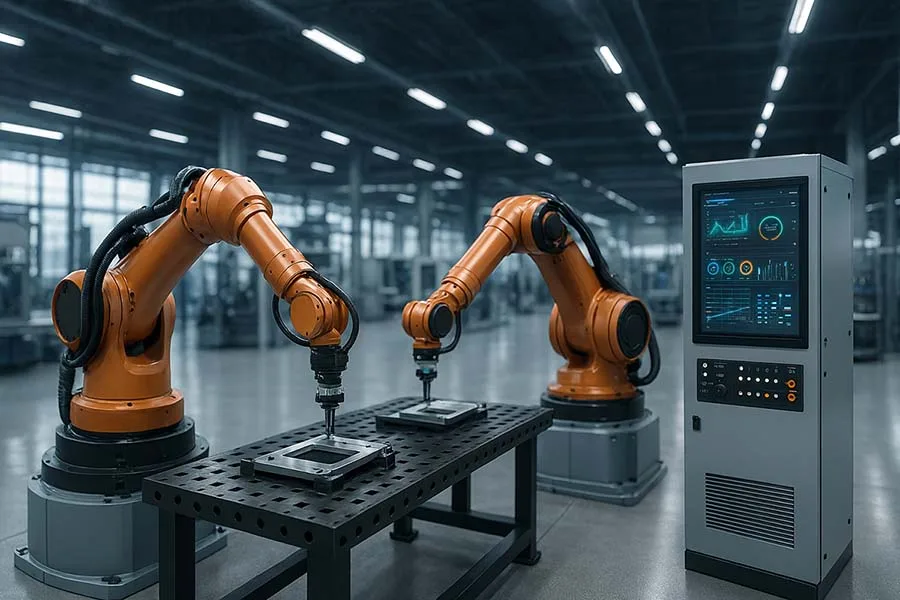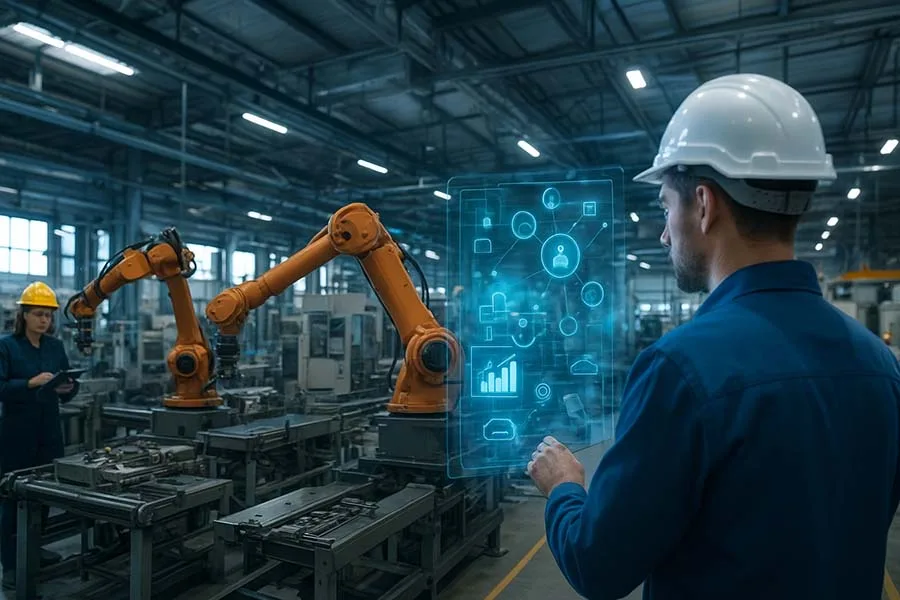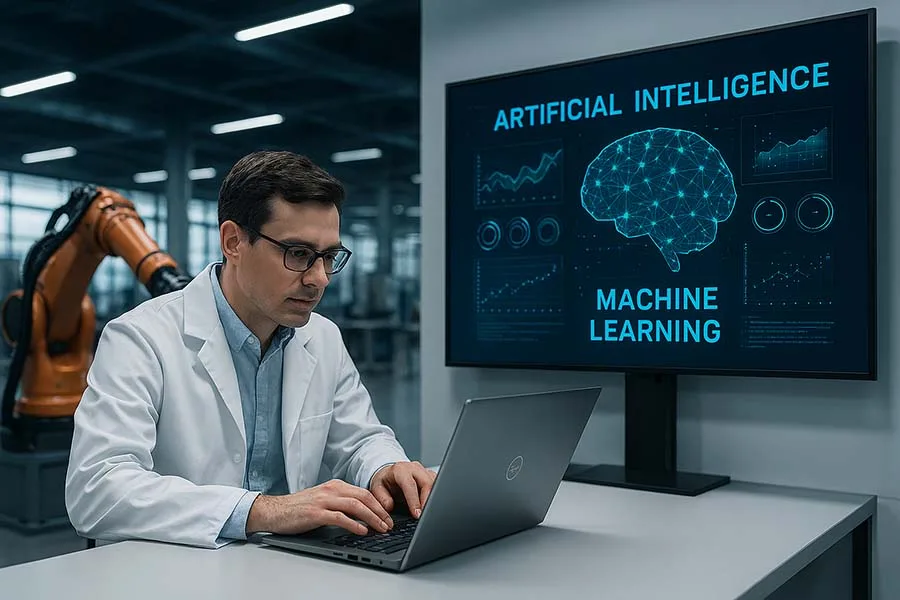Introduction: Manufacturing in the Age of Automation
Modern manufacturing is no longer just about machines and manual labor—it’s about intelligence, efficiency, and connectivity. Robotics and automation are the backbone of smart manufacturing, enabling factories to operate faster, safer, and with greater precision. From assembly lines to predictive maintenance, these technologies are transforming traditional manufacturing into Industry 4.0 ecosystems.
In this article, we’ll explore what robotics and automation really mean, why they’re vital, the technologies that make them work, real-world applications, challenges, and the future of smart factories.
What Are Robotics and Automation in Manufacturing?
Robotics refers to programmable machines capable of performing tasks autonomously or semi-autonomously. Automation is the use of technology to perform repetitive or complex processes without direct human intervention. Together, they:
- Reduce human error
- Increase production speed and consistency
- Enhance safety by taking over dangerous tasks
- Provide real-time data for decision-making
Why Robotics and Automation Are Vital in Smart Manufacturing
- Efficiency & Productivity: Robots work 24/7 with consistent output, eliminating bottlenecks.
- Quality & Precision: Automated systems maintain strict tolerances, reducing defects.
- Safety: Dangerous tasks like welding, heavy lifting, or chemical handling are safer with robots.
- Cost Savings: Automation reduces labor costs, energy use, and material waste.
- Scalability: Factories can quickly adjust production volumes without hiring or retraining large teams.
Lesser-known fact: The first industrial robot, Unimate, was installed at a General Motors plant in 1961, performing simple tasks like welding and stacking. Its impact on efficiency was revolutionary, laying the groundwork for modern robotics.
Core Technologies Behind Robotics and Automation
Modern smart manufacturing relies on a combination of technologies:
- Robotics & Mechatronics: Mechanical design, sensors, and actuators allow precise and flexible operations.
- Industrial Internet of Things (IIoT): Sensors and connected devices enable real-time monitoring and data collection.
- Artificial Intelligence (AI) & Machine Learning (ML): Predictive maintenance, quality control, and process optimization.
- Autonomous Mobile Robots (AMRs) & AGVs: Efficient material handling and logistics within factories.
- Collaborative Robots (Cobots): Safe, human-friendly robots that work alongside employees.
- Advanced Control Systems & Software: Integration of ERP, MES, and SCADA systems ensures smooth operations.
Types of Robotics and Automation in Manufacturing
- Fixed Robots: Stationary robots performing repetitive tasks like welding, painting, or assembly.
- Mobile Robots: Transport materials or products autonomously across the factory floor.
- Collaborative Robots (Cobots): Work alongside humans, assisting in assembly, inspection, or packaging.
- Automated Production Lines: Entire production sequences run autonomously with minimal human oversight.
- AI-Powered Inspection Systems: Automated quality control and defect detection using vision systems.
Real-World Applications
1. Automotive Industry
- Assembly lines: Robots install engines, weld car frames, and paint vehicles.
- Example: Tesla’s Gigafactory uses hundreds of robots alongside humans to assemble vehicles efficiently.
2. Electronics Manufacturing
- Circuit board assembly: Precision robots place tiny components with micron-level accuracy.
- Example: Samsung uses automated pick-and-place robots for semiconductor manufacturing.
3. Food & Beverage
- Packaging and sorting: Robots handle repetitive tasks while maintaining hygiene standards.
- Example: Nestlé uses robotic arms for palletizing and packaging chocolates.
4. Aerospace
- Composite material assembly: Robots apply precise layers of materials, reducing errors.
- Example: Boeing uses robots to assemble large airplane components with minimal human intervention.
5. Pharmaceuticals & Healthcare
- Laboratory automation: Robots handle high-precision tasks like pipetting, sample sorting, and drug packaging.
- Example: Roche employs robotic automation to increase lab efficiency and accuracy.
Challenges and Considerations
While robotics and automation bring massive benefits, challenges exist:
- High upfront costs: Investment in robots, sensors, and control systems is significant.
- Skills gap: Employees need expertise in programming, maintenance, and system integration.
- Cybersecurity: Connected devices are vulnerable to cyber attacks, requiring robust security.
- Integration complexity: Seamlessly linking robots with existing processes and systems can be challenging.
- Change management: Adapting workforce and processes to new technologies requires careful planning.
Future Trends in Robotics and Smart Manufacturing
- AI-driven autonomy: Robots making real-time decisions and adapting without human intervention.
- Human-robot collaboration: Cobots will become even safer, more flexible, and intuitive.
- Edge computing & 5G integration: Real-time data processing for faster, smarter operations.
- Sustainability: Robots optimizing energy use, reducing waste, and enabling circular manufacturing.
- Digital twin integration: Robotic operations simulated and optimized virtually before implementation.
Fun fact: Some modern factories are experimenting with fully automated “lights-out” manufacturing, where robots operate overnight without any human supervision.
Robotics and Automation FAQ
Further Read
- Core Foundations of Industry 4.0: The Tech Stack Explained
- Industrial Internet of Things (IIoT): Connecting Machines, Data, and People
- Digital Twin Technology: From Concept to Real-World Applications
- Robotics and Automation: The Heart of Smart Manufacturing
- Artificial Intelligence (AI) and Machine Learning: Smarter Manufacturing
- Augmented Reality (AR) and Virtual Reality (VR): The Human-Tech Interface
- Data Analytics and Cloud Computing in Industry 4.0
- Cybersecurity in Industry 4.0: Protecting the Smart Factory
- Integration and Interoperability in Industry 4.0
- Benefits of Understanding the Core Foundations: People, Processes, and Technology
- Challenges and Barriers in Industry 4.0: Overcoming the Roadblocks to Smart Manufacturing
- The Future of Manufacturing: Towards Industry 5.0
- Air Motors Buying Guide | Vane vs Piston Motors Explained for Industrial Buyers
Conclusion
Robotics and automation are the heart of smart manufacturing. They empower factories to produce faster, safer, and more efficiently while unlocking new levels of quality and flexibility. As technologies like AI, cobots, and digital twins continue to evolve, the future of manufacturing will be increasingly autonomous, interconnected, and intelligent.
How is your industry adopting robotics and automation? Share your insights and experiences in the comments below!





